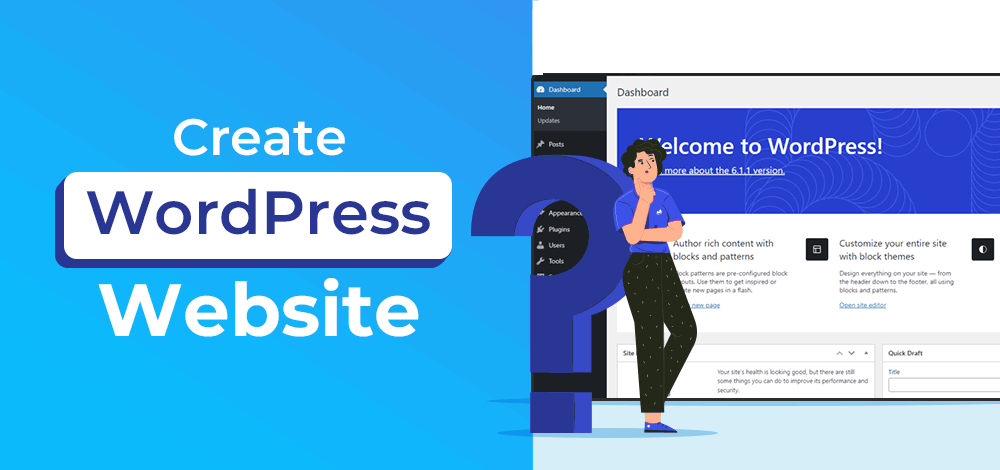How to Build a WordPress Website from Scratch in 5 Easy Steps
 Hire Laravel Developers
Hire Laravel Developers
Introduction
In today's digital age, having a website is no longer optional; it's essential. Whether you're a small business owner, a blogger, or just someone looking to establish an online presence, a website can help you reach a broader audience. But where do you start? If you're considering building a website, WordPress is an excellent choice. It's user-friendly, highly customizable, and powers over 40% of all websites on the internet.
Step 1: Choose a Domain Name and Hosting Provider
Picking the Perfect Domain Name
Your domain name is your website's address on the internet. It's what people will type into their browser to find you. When choosing a domain name, keep it simple, memorable, and relevant to your content or business. Avoid using numbers or hyphens, and try to opt for a .com extension as it's the most recognized and trusted.
Selecting a Reliable Hosting Provider
Hosting is where your website lives on the internet. A good hosting provider ensures your site runs smoothly and is always accessible. There are various hosting options available, including shared hosting, VPS hosting, and dedicated hosting. For beginners, shared hosting is usually sufficient and affordable. Look for providers with excellent uptime, good customer support, and positive reviews.
Connecting Your Domain to Your Hosting
Once you've chosen your domain name and hosting provider, you'll need to connect them. This typically involves updating your domain's DNS settings to point to your hosting provider. Most hosting companies offer detailed instructions or customer support to help you through this process.
Step 2: Install WordPress
One-Click WordPress Installation
Many hosting providers offer a one-click WordPress installation feature. This tool simplifies the process by automatically installing WordPress on your hosting account. You'll just need to follow a few prompts, and in a matter of minutes, your WordPress site will be up and running.
Manual WordPress Installation
If you prefer to install WordPress manually, you'll need to download the WordPress software from WordPress.org, upload it to your hosting account via FTP, and run the installation script. This method gives you more control over the installation process but requires a bit more technical knowledge.
Initial WordPress Setup
After installing WordPress, you'll need to complete the initial setup. This includes selecting your site's title, creating an admin account, and setting your preferred language and timezone. These steps are straightforward, and WordPress provides clear instructions along the way.
Step 3: Select and Install a Theme
Free vs. Premium Themes
WordPress offers a vast array of themes, both free and premium. Free themes are great for beginners and those on a budget, but they often come with limited customization options. Premium themes, on the other hand, offer more features, better support, and are generally more polished.
How to Install a Theme
To install a theme, navigate to the Appearance section in your WordPress dashboard and click on Themes. You can browse and install free themes directly from the WordPress repository. For premium themes, you'll need to upload the theme files and activate the theme.
Customizing Your Chosen Theme
Once your theme is installed, you can customize it to match your brand and style. Most themes come with a built-in customizer that allows you to change colors, fonts, layouts, and more. Spend some time exploring these options to make your site unique.
Step 4: Add Essential Plugins
What Are Plugins and Why You Need Them
Plugins are add-ons that enhance the functionality of your WordPress site. They can help you with SEO, security, backups, performance, and more. Think of plugins as apps for your website that add extra features without needing to write code.
Must-Have Plugins for Every WordPress Site
Some essential plugins include:
Yoast SEO: Helps optimize your site for search engines.
Wordfence Security: Provides robust security features.
WP Super Cache: Improves site performance by caching static content.
UpdraftPlus: Offers easy backups and restores.
Contact Form 7: Simplifies creating contact forms.
How to Install and Activate Plugins
To install a plugin, go to the Plugins section in your WordPress dashboard, click Add New, and search for the plugin you want. Click Install Now, and once installed, activate it. Some plugins may require additional setup, but they usually come with detailed instructions.
Step 5: Create Key Pages and Content
Essential Pages Every Website Needs
Every website should have a few essential pages:
Home Page: The first impression of your site.
About Page: Information about you or your business.
Contact Page: How visitors can get in touch with you.
Blog Page: Where you'll post regular updates and content.
Services/Products Page: Details about what you offer.
Tips for Creating Engaging Content
Engaging content is crucial for keeping visitors on your site. Use clear, concise language, break text into short paragraphs, and include images or videos to make your content visually appealing. Always write with your audience in mind, and provide value in every post.
Using the WordPress Block Editor
The WordPress Block Editor (Gutenberg) makes it easy to create and edit content. It uses blocks for different types of content, such as text, images, videos, and more. This approach is intuitive and allows for greater flexibility in designing your pages and posts.
Optimizing Your WordPress Site for SEO
Importance of SEO
Search Engine Optimization (SEO) is vital for driving traffic to your website. By optimizing your site for search engines, you increase your chances of ranking higher in search results, making it easier for people to find you.
On-Page SEO Best Practices
On-page SEO involves optimizing individual pages on your site. This includes using relevant keywords, writing compelling meta descriptions, using header tags appropriately, and ensuring your site is mobile-friendly.
Using SEO Plugins
Plugins like Yoast SEO can simplify the optimization process. They provide tools for keyword analysis, readability checks, and more. By following the plugin's recommendations, you can improve your site's SEO significantly.
Maintaining and Updating Your WordPress Site
Regular Updates and Backups
Keeping your WordPress site updated is crucial for security and performance. This includes updating WordPress core, themes, and plugins. Additionally, regular backups ensure you can restore your site in case of any issues.
Security Measures
Protecting your site from threats is essential. Use strong passwords, enable two-factor authentication, and regularly scan your site for malware. Plugins like Wordfence can help with these tasks.
Monitoring Site Performance
Regularly check your site's performance using tools like Google Analytics and Google Search Console. These tools provide insights into your site's traffic, user behavior, and any issues that need addressing.
Conclusion
Building a wordpress developers for hire from scratch might seem daunting, but by following these five easy steps, you can create a professional-looking site in no time. Start with a solid foundation by choosing the right domain and hosting, then install WordPress and select a theme that suits your brand. Add essential plugins to enhance functionality and create engaging content to attract and retain visitors. Finally, optimize your site for SEO and maintain it regularly to ensure it runs smoothly. Ready to get started? Dive in and start building your online presence today!
Subscribe to my newsletter
Read articles from Hire Laravel Developers directly inside your inbox. Subscribe to the newsletter, and don't miss out.
Written by

Hire Laravel Developers
Hire Laravel Developers
Discover top Laravel developers for hire on Hashnode.com. Elevate your projects with our skilled professionals. Let's collaborate and bring your ideas to life!